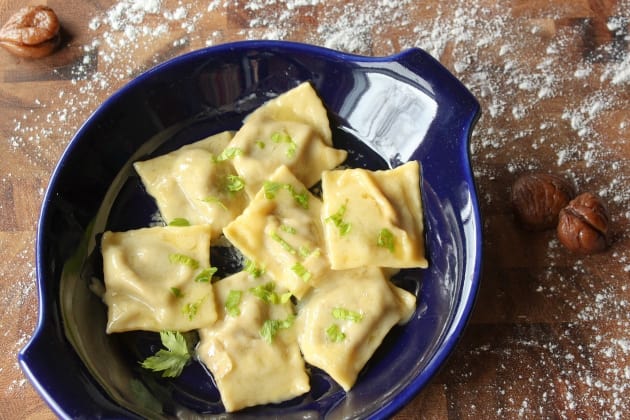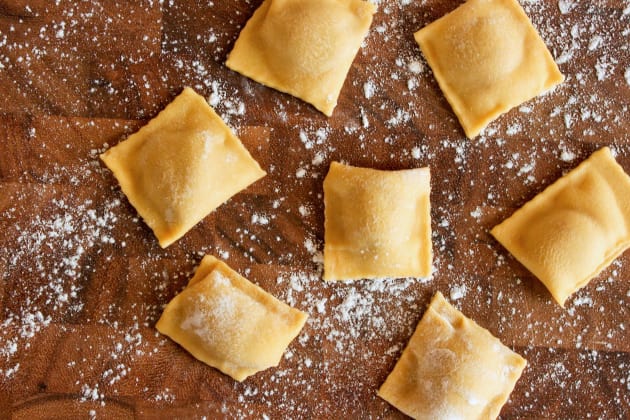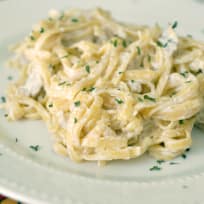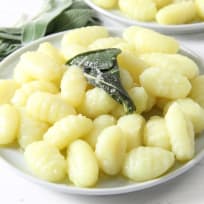Chestnut Agnolotti Recipe
Casey Barber | Good. Food. Stories.This Chestnut Agnolotti recipe is sure to impress your guests. Prepare now for a rich, delicious dinner.
I feel like I should put a big amusement park-style disclaimer here:
Chestnut agnolotti is not intended for the fat-phobic, cheese-phobic, those who don't love rich flavors, or anyone with a heart condition.
It's a showstopper, something to pull out when you really need to impress the in-laws or seal the deal with a potential mate.
That's not to say it doesn't make an incredible weeknight dinner (or lunch eaten directly over the stove, as I may have done when cooking up the leftovers after photographing them today!).
Making fresh pasta isn't as time-consuming as most people assume: start to finish, it takes me about an hour to make enough pappardelle, tagliatelle, or fettuccine to feed four to six people, and the rewards and adulation that come from setting a bowl of fresh pasta in front of dinner guests make it my go-to meal when we're having company.
But filling and shaping stuffed pasta adds another level of focus to the ritual, and when you're filling said pasta with creamy, luxurious chestnuts and mascarpone cheese… well, if this is something you're doing on a random Tuesday night, you're as crazy as I am.
Chestnuts have been a staple of Italian cuisine for millennia, as nutritious sustenance for the soldiers of the Roman empire to banquet delicacies for aristocracy during the Renaissance to lowly peasant fare (cucina povera) by the time of the Industrial Revolution.
But if you think I'm roasting and peeling them by hand like a peasant for this chestnut agnolotti, you're perhaps even crazier that I first assumed. A 14-ounce jar of pre-steamed chestnuts is my secret weapon, readily available at grocery stores from Trader Joe's to Whole Foods and worth every penny in time and frustration saved.
Pairing chestnuts with Italian mascarpone cheese isn't my original idea: I nicked it from a dish in The French Laundry cookbook The French Laundry Cookbook that's even more decadent than this one.
But where Thomas Keller adds truffle oil, cream, and mild Fontina to his original version, I pair mine with sweet but pungent Robiola, a gooey northern Italian cheese encased in a white rind. Feel free to substitute gorgonzola dolce or another creamy blue if you love that strong, sinus-clearing flavor.
For a final garnish, celery leaves - yep, from the tips of each stalk, the things you probably toss in the compost instead of giving them a second glance! - give a bitter, grassy note to the chestnut agnolotti.
If you're celery-averse, sage or flat-leaf parsley would work equally well here, but I've become addicted to adding an extra hit of bright flavor with these bonus leaves. Hint: they're equally as delicious in risotto, chowder, and other creamy, salty dishes.
A word on agnolotti: they're essentially mini ravioli, and though I've seen a number of ways to shape and fill these tiny buggers, I stick with the really easy method of folding and slicing the pasta into small (around 1 inch) pillows.
Try not to leave too much excess dough flapping at the edges, since the good stuff is in that luxurious chestnut filling.
Are you tired of the dinner routine?
Stuck in a rut or looking for fun new recipes to try?
Our Facebook Group is growing every day! If you haven’t joined yet, we invite you to come check it out and join the fun.

You can ask for recipe ideas, talk about cooking techniques, or get help figuring out the right new pan set for you. If you’ve already joined, invite a friend along!
Chestnut Agnolotti Recipe
Ingredients
For the Filling:- 1 cup Chestnuts, peeled, steamed
- 1 cup Vegetable Broth
- 2-3 Bay Leafs, depending on size
- 1/4 cup Mascarpone Cheese
- 1/4 cup Ricotta Cheese
- 1/4 teaspoon Kosher Salt
- 1/4 teaspoon Black Pepper
- 12 ounces All-Purpose Flour
- 4 large Eggs
- 1 tablespoon Extra Virgin Olive Oil
- 1 teaspoon Kosher Salt
- 4 tablespoons Unsalted Butter
- 1/4 pound Robiola Cheese, left at room temperature until soft and gooey
- Kosher Salt, to taste
- Black Pepper, to taste
- 1 tablespoon Fresh Parsley
Directions
Make the Filling:
- Add the chestnuts, broth, and bay leaves to a small saucepan and bring to a simmer over medium heat. Cook for about 15 minutes until the broth has reduced to about 1/2 cup and the chestnuts are tender enough to fall apart when pierced with the tip of a paring knife.
- Discard the bay leaves and transfer the chestnuts and broth to a food processor or powerful blender. Add the mascarpone, ricotta, salt, and pepper, and blend until the chestnuts are completely pureed and smooth.
- Transfer the filling to a lidded container and refrigerate for at least an hour until chilled and firm.
While the filling chills, make the dough:
- Weigh or measure the flour into a large mixing bowl, then make a well in the middle of the flour with your fingers. Add the eggs, olive oil, and salt to the well and use your hand as a paddle to create a shaggy pasta dough, stirring with a whirlpool motion and working the flour into the liquid from center of the bowl to the edges.
- When nearly all the flour is incorporated but the dough is still crumbly, dump it out onto a clean work surface and begin to knead and shape into a dough ball. Knead for about 4-5 minutes, until the dough is golden, smooth, and pliant. (You may need to dust the work surface and your hands with extra flour, but shouldn't need too much.) Cover the dough with the mixing bowl or a piece of plastic wrap and let it rest for 15 minutes.
- Prepare as much clean counter space as you can by laying out large cutting boards or clean, non-terrycloth towels lightly dusted with flour. You're going to end up with 8 pasta strips that are each about 18 inches long, so prep accordingly.
- Divide the rested dough into 4 equal pieces, shape each piece into a rough rectangle, and dust each lightly with flour. Set your pasta roller attachment to 1 (the thickest setting), and gently feed the dough through the rollers. Take the stretched dough, fold it into thirds like a piece of paper, and feed it through again. Fold and feed one more time.
- After this three-step pass on the thickest setting, turn the rollers progressively thinner and feed the dough through once on each setting until the dough is thin and translucent enough to see the shape of your hand through when held against the light. (I usually take mine to 5 on the KitchenAid mixer setting.) Once you're halfway through the rolling process, the dough strips will get very long, so cut them in half to make 8 strips instead of 4, and continue to pass them through the roller until you've reached your desired thinness.
Assemble the pasta:
- Lay a pasta strip lengthwise in front of you and scoop 1/2 teaspoon blobs of filling spaced about a finger's width apart on the lower half of the strip. These should be small filled pastas and it's ok to space the filling blobs fairly closely; my mistake is to leave too much dough between them and I end up cutting away more than I want every time. You should be able to get about 8-10 blobs on each sheet, but your mileage may vary. Don't sweat it too much.
- When the blobs are placed, fill a small bowl with water. Dip your fingers in the water and trace squares around each blob to lightly wet the dough.
- Dry your hands thoroughly and gently fold the dough over the filling like you were tucking each blob into bed at night, pressing between each blob to squeeze out any air pockets. Use a pastry or pizza cutter to slice off excess dough and cut each pasta into squares or half moons—your choice.
- Repeat with the remaining pasta and filling.
Make the sauce and finish the dish:
- Bring a 4-quart pot of salted water to a boil, then add the pasta in batches, making sure not to crowd the pot so the water dips below a boil. The pasta will take less than a minute to cook, so scoop the cooked agnolotti out with a spider or metal strainer and reserve until the sauce is ready.
- While the water is coming to a boil, melt the butter in a large skillet over medium-low heat. Slice the rind off the top of the cheese and scoop the goopy insides into the skillet. Cook, stirring, just until the cheese melts and is incorporated into a sauce. Season with salt and pepper to taste.
- Add the reserved cooked agnolotti to the sauce and toss to coat lightly. Garnish with celery leaves or the herb garnish of your choice. Serve immediately.
Notes
- You may also use 1 cup of chicken broth in lieu of vegetable broth.
- 12 ounces of flour is approximately 2.75 cups. You will also need a little more for kneading/dusting.
- You can also use minced celery leaves or sage in lieu of parsley.
- Published:
- Modified:
- Author:
- Casey Barber
- Cooking Method:
- Boiled
- Cuisine:
- Italian
- Category:
- Dinners
- Tags:
- Italian, Dinners, Pasta, Boiled, Ravioli
- Related Recipes:
- Italian Recipes, Dinner Recipes, Pasta Recipes, Boiled Recipes, Ravioli Recipes
- Recipe Yields:
- 70 agnolotti
- Prep Time:
- Cook Time:
- Total Time:
- Related Post:
-
Published:
Author: Casey Barber
Recipe Yields: 70 agnolotti
Prep Time: 75 minutes
Cook Time: 150 minutes
Total Time: 225 minutes
Nutrition Facts
Amount Per Serving










